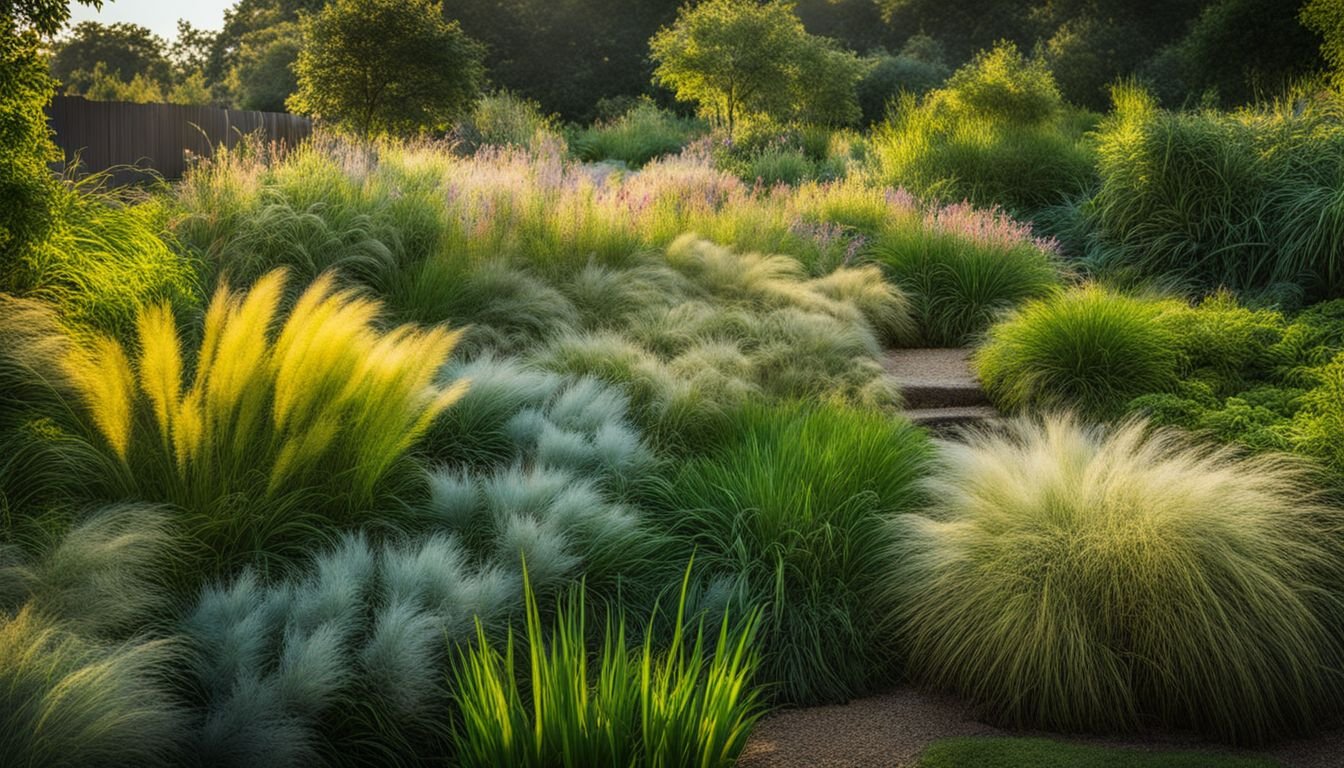Choosing the right Lomandra can transform your garden, but with so many varieties, it’s easy to feel overwhelmed. These Australian native grasses are renowned for their resilience and versatility in various landscapes.
Our guide simplifies the selection process, matching you with the perfect Lomandra for your gardening needs. Discover your ideal variety here!
Key Takeaways
- Lomandras are versatile, low – maintenance plants that thrive in various Australian climates and soil types, making them ideal for different garden settings.
- Varieties like ‘Lime Tuff’ and ‘Katie Belles’ offer vibrant green foliage year – round with minimal care needed, suited even for extreme weather conditions including drought and frost.
- These native grasses can serve multiple purposes such as erosion control, filling out mass plantings or acting as groundcover whilst also providing habitat for local wildlife.
- When selecting a Lomandra variety, consider factors like climate resilience, soil type adaptability, garden size compatibility, and the desired level of maintenance to ensure a thriving addition to your outdoor space.
- Planting a suitable Lomandra can result in both an aesthetically pleasing landscape feature and functional benefits like soil stabilisation without requiring excessive upkeep.
Understanding Lomandra
 Lomandra longifolia and its cousins are tough, evergreen plants that thrive with minimal fuss. Their strappy leaves form dense clumps, making them ideal for adding texture to garden beds or using as a reliable border.
Lomandra longifolia and its cousins are tough, evergreen plants that thrive with minimal fuss. Their strappy leaves form dense clumps, making them ideal for adding texture to garden beds or using as a reliable border.
They’re a smart choice if you’re after low-maintenance greenery that withstands drought and frost alike. These resilient natives adapt well to various soil types, from sandy dunes to rich loam, requiring little in terms of additional nutrients or pampering.
This group of plants boasts not only versatility but also beauty. Some varieties produce sweetly scented flowers that attract beneficial insects whilst others offer fine foliage perfect for modern landscapes.
Lomandras’ root systems are robust and help stabilise soil, reducing erosion on slopes or banks. Ready to explore which lomandra variety will suit your garden’s aesthetic and functional needs? Let’s delve into the best options available for every type of space and preference next.
Best Lomandra Varieties for Your Garden

Embark on a journey to elevate your garden with the perfect Lomandra, where myriad varieties offer unique benefits tailored to diverse gardening needs. Uncover a range that spans from the low-maintenance ‘Lime Tuff’ to the resilient and frost-tolerant choices, each poised to transform your outdoor space into an oasis of texture and hardiness.
‘Lime Tuff’: Ideal for Easy Care Gardens
‘Lime Tuff’ earns its name by being a robust and hardy addition to any garden, thriving in full sun or partial shade. Its bright lime green foliage forms a dense tuft, reaching up to 80 cm in height, perfect for creating vibrant contrasts with other plants.
Adaptability is one of ‘Lime Tuff’s many strengths; it flourishes in various soil types—whether loam, clay loam or free-draining clay—and stands up well against frost. This makes it an excellent choice for gardens across different climates.
Caring for ‘Lime Tuff’ is straightforward – occasional trimming keeps the evergreen grass looking neat and tidy. For those keen on minimal maintenance gardening, this cultivar doesn’t disappoint: regular pruning isn’t necessary as ‘Lime Tuff’ maintains its compact shape well.
Every three to four years you might give it a more extensive trim, cutting back half the foliage height in spring to rejuvenate growth. Mass planting can be visually stunning too; just ensure each plant has enough space—2 to 3 per square meter promotes good air circulation, particularly important in humid coastal regions where airflow helps prevent disease onset.
Lomandra Confertifolia Subsp. Pallida: The Hardy Choice
Lomandra Confertifolia Subsp. Pallida stands as a robust contender for gardeners seeking a plant that thrives with minimal fuss. This variety’s resilience shines through its drought tolerance and frost hardiness, making it an excellent pick for regions prone to extreme weather conditions.
With graceful evergreen foliage, it adds year-round visual interest to gardens, requiring little more than the occasional prune to maintain its compact form.
Its adaptability makes Lomandra Confertifolia Subsp. Pallida perfect for mass planting or serving as an elegant groundcover in diverse landscapes across Australia. Garden enthusiasts can count on this hardy choice to endure through tough times while preserving the aesthetic appeal of their outdoor spaces.
Moving from strength to durability, let’s consider how ‘Shara™ Lomandra fluviatilis ‘ABU7’ fares in different climate extremes.
‘Shara™ Lomandra fluviatilis ‘ABU7’: Best for Hot or Cold Climates
‘Shara™ Lomandra fluviatilis ‘ABU7’ thrives in a range of climates, making it an excellent choice whether you’re dealing with the scorching sun or frosty temperatures. Its versatility shines as it can gracefully handle both drought and heavy rain, ideal for those unpredictable weather patterns.
This ornamental grass is not just tough; it also adds elegance to any garden space with its fine foliage and structure.
Gardeners appreciate ‘Shara™’ for its low maintenance needs, making their seasonal gardening tasks simpler while providing a lush green look year-round. It happily grows in full sun or shade, catering to your landscape’s unique conditions.
If your region experiences harsh climate swings, this frost-tolerant plant could be the resilient touch your garden needs.
Lomandra Echidna Grass: Perfect for a Unique Touch
Lomandra Echidna Grass stands out with its spiky foliage and resilience, making it a captivating feature in any garden. It thrives across various climates, embodying versatility that caters to both the needs of wildlife shelters and the aesthetic desires of gardeners.
This unique plant offers not just visual appeal but also practical benefits like erosion control, without demanding high maintenance.
Planting Lomandra Echidna Grass adds an element of surprise to your garden’s texture and form. Its ability to fit into different styles makes it ideal for rain gardens or drought-tolerant landscapes.
Garden enthusiasts will appreciate how this grass weaves itself seamlessly into their existing design while providing a habitat for local fauna.
Lomandra ‘Katrinus Deluxe’: The Deluxe Choice
Gardeners seeking a striking addition to their outdoor space will find ‘Katrinus Deluxe’ an ideal choice. As a versatile native grass, it offers both beauty and resilience, adapting seamlessly to various garden conditions.
This low-maintenance plant boasts lush foliage year-round, eliminating the need for constant pruning or fuss. Its ability to thrive in diverse climates makes it a favorite among plant enthusiasts.
Choosing ‘Katrinus Deluxe’ means enjoying the luxury of a robust and attractive garden feature without the high upkeep commonly associated with deluxe plants. It stands out with its rich green blades that add texture and movement to your garden landscape.
Whether planted en masse for impact or used as an elegant accent piece, ‘Katrinus Deluxe’ elevates any gardening project with ease and grace.
‘Katie Belles’: For a Spectacular Display
‘Katie Belles’ Lomandra stands out with its stunning weeping foliage and vibrant green colour, creating a perfect backdrop for any garden. This variety brings an eye-catching display that lasts all year round, making it an essential choice for those wanting to inject life into their landscapes.
Its graceful blades sway gently with the breeze, providing soothing movement that can transform your outdoor space into a tranquil retreat.
Ideal for erosion control and acting as wildlife shelter, ‘Katie Belles’ is both functional and beautiful. It’s remarkably frost tolerant and thrives in various conditions from coastal gardens to windy rooftops, ensuring robust growth no matter where you plant it.
With minimal maintenance required, this low-care gem allows you to enjoy spectacular garden views without the ongoing effort often associated with other plants.
Factors to Consider When Choosing Lomandra
Selecting the right Lomandra for your garden involves weighing up various factors unique to your environment and gardening aspirations; delve into our detailed guide to make an informed choice that will thrive in your personal landscape.
Climate
Climate plays a pivotal role in deciding which Lomandra variety will thrive in your garden. Before you make your choice, consider the weather patterns where you live. Are your summers scorching or are frosty winters more of a concern? Luckily, Lomandras are versatile and can withstand various conditions – some bask in full sun while others prosper in cooler shaded areas.
For those living in places with extreme temperatures, the ‘Shara™ Lomandra fluviatilis ‘ABU7’ is an excellent choice due to its robust hot and cold climate tolerance.
Gardeners should embrace their local environments instead of fighting against them. Queenslanders might favour Lomandra hystrix for its ability to handle humid QLD conditions with ease.
Meanwhile, those situated in areas prone to drought can look towards varieties like ‘Lime Tuff’ that bring life to gardens even when water is scarce. Your plants need not only survive but flourish, so choosing a lomandra well-suited to your region’s climate ensures less hassle and more lush greenery throughout the year.
Soil type
Considering the soil type is crucial when selecting Lomandras, as these robust plants accommodate a range of conditions. They thrive in both wet and dry soils, making them versatile for different garden environments.
Whether your backyard has rich loam or hard clay, there’s a Lomandra variety ready to fit right in. Plus, these plants are champions at erosion control – if you’ve got slopes that tend to wash away with rain, planting Lomandras can help hold your precious soil in place.
Lomandra varieties not only tolerate diverse soil types but also stand up well to salty winds and spray in coastal areas. Their salt tolerance ensures they remain lush and healthy even when other plants might struggle.
Gardeners living by the sea can plant Lomandras without worry because these tough grasses will endure where less resilient species may falter. Keep these considerations in mind when browsing at your favorite online nursery or scouring seasonal gardening tips for that durable yet delightful addition to your landscape.
Garden size
Garden size plays a crucial role when selecting the right Lomandra for your outdoor space. Compact varieties like ‘Lime Tuff’ and ‘Katie Belles’ deliver lush, full foliage without overcrowding smaller areas.
These versatile plants adapt well, thriving in both cosy corners and expansive landscapes.
For larger gardens, consider mass planting with options such as Lomandra Confertifolia Subsp. Pallida or ‘Shara™ Lomandra fluviatilis ‘ABU7’. They create a stunning sea of green that’s both drought tolerant and easy to maintain.
Tailor your choice to match your garden’s proportions, ensuring each plant has room to flourish while enhancing the overall aesthetic of your lawn or landscape.
Maintenance level
Maintaining your Lomandra plants is straightforward, making them an excellent choice for gardeners who value both beauty and ease of care. They thrive with regular watering and benefit from mulching which helps to retain soil moisture and suppress weeds.
Once established, these resilient plants need minimal attention. Seasonal pruning can encourage new growth and keep the plant looking fresh after it flowers.
Choosing a Lomandra variety like ‘Lime Tuff’ simplifies garden maintenance even further. Its robust nature means it’s suited to different climates across Australia, including those areas prone to frost.
You won’t spend your weekends fretting over your Lomandras; instead, enjoy their lush greenery with little effort. Whether you’re nurturing a small backyard or managing large landscaped spaces, low-maintenance Lomandras are hardy companions that keep flourishing year-round without demanding too much time or skill from you.
How to Grow Lomandra Successfully
Growing Lomandra is straightforward and rewarding. These resilient plants thrive with the right care, offering beauty and practical benefits to your garden. Here’s how to ensure they flourish:
- Choose a suitable spot in your garden that receives full sun or partial shade. Lomandra’s adaptability makes it a great fit for various light conditions.
- Prepare the soil by loosening it and mixing in a quality potting mix, ensuring proper drainage for healthy root development.
- Plant your Lomandra seeds or seedlings during mild weather, avoiding extreme temperatures that can stress young plants.
- Water the plants regularly after planting to establish roots, but once established, reduce watering as Lomandras handle dry spells well.
- Apply a slow – release fertiliser early in the growing season to encourage strong growth and lush foliage.
- Prune dead leaves and spent flower stems annually to keep your Lomandra looking neat and helping prevent fungal diseases.
- Look out for pests like mealybugs and treat them promptly with an appropriate insecticide from local nurseries or gardening centres.
- Protect your plants from frost by mulching around the base, improving frost tolerance during cold snaps.
Explore More on Lomandra
Dive deeper into the world of Lomandra to uncover a variety of species that could transform your garden. Research shows that these sturdy grass-like plants not only add aesthetic value but are also champions in low-maintenance gardening, perfect for both novice and expert gardeners.
Discover limited edition plants, advance sale notices, and explore beyond common varieties to find a Lomandra that’s distinctively suited to your personal taste and garden conditions.
Plant enthusiasts will appreciate the resilience of Lomandras as they thrive in various climates across Australia, including QLD where extremes can be common. Utilise online payment options for easy purchase or contact us during office hours if you have questions about which Lomandra may be best for you.
Take advantage of internet banking or Australia Post to secure your new plant additions without hassle. As part of our privacy policy, rest assured all transactions are handled with the utmost care and confidentiality.
Frequently Asked Questions About Lomandra
7. Frequently Asked Questions About Lomandra:.
Delve into common queries that both novice and expert gardeners share about caring for Lomandra, clarifying doubts and nurturing knowledge to ensure your plants thrive with vigour.
Discover the intricacies of sunlight requirements, watering schedules, and optimal planting periods as we address these pertinent questions with clear-cut answers tailored for plant enthusiasts.
Do Lomandras require full sun?
Lomandras are incredibly versatile and don’t necessarily need full sun to thrive. These resilient plants have adapted to flourish in both shaded areas and sunny spots, making them a perfect addition for gardeners who deal with varied light conditions in their yards.
Their adaptability extends to different climates too; whether your garden gets the harsh Australian Eastern Standard Time (AEST) sun or sits in a cooler spot, Lomandras will do well.
You’ll find that many varieties like the robust ‘Lime Tuff’ can withstand direct sunlight without batting an eye. This toughness makes them ideal candidates for those challenging locations where other plants might struggle.
From preventing erosion on windy rooftops to bringing life into dry or wet regions, Lomandra’s ability to grow under diverse lighting conditions is one of its greatest assets as a plant choice for landscapes across QLD and beyond.
How often should I water my Lomandra?
Watering your Lomandra correctly plays a crucial role in its growth and health. During the establishment phase, which can take a few months, ensure that you water it regularly to help the roots settle into their new environment.
You might find yourself reaching for the watering can or hose more frequently then—usually once or twice a week, depending on weather conditions.
As your plant matures, Lomandras become quite drought-tolerant. They’ll need less of your attention with the watering routine; however, don’t let them go completely dry for long periods.
Monitoring soil moisture is key—give them a drink when the top inch of soil feels dry to touch. If you’re living in coastal areas where salt spray is common, rest assured knowing these tough plants will still thrive with proper care.
When is the best time to plant Lomandra?
After getting a handle on the watering routine for your Lomandra, you might wonder about the ideal planting time. Good news: these resilient plants defy the usual gardening constraints! Lomandras can settle into your garden at any point during the year.
Their robust nature allows them to adapt and thrive across seasons, so timing is more about convenience than necessity. Whether it’s the coolness of autumn or summer’s heat, these grasses will tough it out.
For those in frost-prone regions or dealing with high coastal humidity, opt for varieties like ‘Lime Tuff’, which demonstrate remarkable endurance in extreme conditions. Choosing such hardy types ensures that no matter when you get around to planting them, they’ll rise to meet the challenge of their new home with vigor.
Conclusion
Seize the opportunity to elevate your garden with a Lomandra that fits like a glove. Whether you seek low-maintenance charm or hardy resilience, there’s a variety tailored just for you.
Unleash the beauty and practicality of these native grasses in your special space. Choose wisely and watch as your chosen Lomandra thrives, transforming your outdoor oasis. Your perfect plant awaits — go find it!
FAQs
1. What types of Lomandra varieties can I find in QLD?
In Queensland, you’ll discover a range of Lomandra varieties that thrive in our climate, from compact forms suited to borders to robust types ideal for large areas.
2. How do I choose the right Lomandra for my garden?
Consider your needs: whether you desire a grass tree look or low maintenance ground cover. Then select a variety that matches your aesthetic and practical requirements.
3. What’s the best way to get advice on Lomandras suitable for my area?
You can pop into your local nursery or send an enquiry to a PO Box specialising in native plants during AEST working hours for expert guidance tailored to your region.
4. Can I grow different kinds of Lomandras together?
Absolutely! Mixing various Lomandras creates texture and interest; just ensure they have similar sunlight and water needs for harmonious growth.
